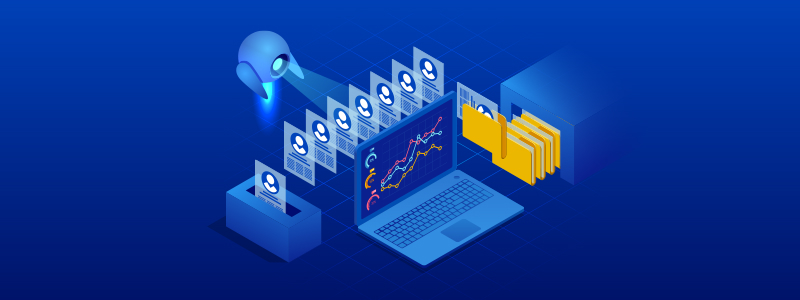APIs play a crucial role in modern digital technology, facilitating communication between different software applications seamlessly and efficiently. From online shopping to social media platforms, APIs enable diverse functionalities that enhance user experiences and drive innovation.
In this blog post, we’ll explain what APIs stand for, how API works, and how they benefit businesses.
What Does API Stand For?
‘API’ stands for Application Programming Interface.
Application: refers to any software with a distinct function.
Interface: serves as a contract of service between two applications.
This contract delineates how the applications communicate through requests and responses. APIs facilitate seamless interaction and integration between different software systems, enabling them to share data and functionalities efficiently.
It defines the methods and data formats that applications can use to request and exchange information. APIs enable the integration of different software systems, allowing them to work together, share data, and access each other’s functionalities. Think of APIs as a middleman between two applications that need to share information.
In the past, APIs were not so common. Initially, they were integrated as operating system libraries. Hence, they were limited to the systems on which they were operated. APIs’ primary purpose was to pass messages from one mainframe to another. It took about 30 years for APIs to evolve beyond the local environment.
By 2000, APIs had gained immense popularity and had become integral to advanced data integration. Today most organizations build custom and term APIs for internal use or providing seamless service to their customers.
Why do we need API?
APIs have become increasingly important in modern software development. They allow developers to focus on building new features rather than re-inventing the wheel. For example, a mobile app developer might use an API to access a weather service rather than building their own weather functionality from scratch. Here are some more reasons why APIs have become essential today:
Interoperability
APIs facilitate interoperability between diverse software systems. They allow applications and services developed by different organizations or teams to work together, share data, and provide integrated solutions.
Modular Development
APIs enable modular development by breaking down complex systems into smaller, manageable components, which makes it easier to develop, test, and maintain software, as developers can focus on building and updating specific functionalities.
Cross-Platform Integration
APIs enable cross-platform integration, allowing applications to work across different devices and environments. For example, a mobile app can use APIs to communicate with a server, and the same server can serve data to a web application or other client devices.
Data Access and Sharing
APIs define a structured way in which data is exchanged between applications. The data is typically formatted in a specific language such as JSON (JavaScript Object Notation) or XML (eXtensible Markup Language). This standardized structure makes it easy for both the requesting application and the providing system to interpret and process the data.
How Do APIs Work?

APIs reside between the web server and an application and act as a middleman between the client and the server. Think of APIs as a translator between two people who speak different languages. When two people who speak different languages want to communicate, they need a translator to help them understand each other.
Similarly, when two applications want to communicate, they need an API to help them understand each other’s requests and responses. An example would be how Google and Facebook work seamlessly with smartphone apps and websites to log in quickly. It simplifies development, saving both software developers and their users considerable time and money.
Types of APIs
There are several different APIs, each with its unique purpose and functionality. Some of the most common types of APIs include:
- RESTful APIs: Representational State Transfer (REST) APIs are a type of web-based API that use HTTP requests to access and manipulate data. They are commonly used in web development and allow for data transfer in a standardized, easy-to-understand format.
- SOAP APIs: Simple Object Access Protocol (SOAP) APIs are another web-based API type that uses XML to transfer data. Soap APIs are used in enterprise applications and allow complex interactions between applications.
- GraphQL APIs: GraphQL is a query language for APIs that Facebook developed. It enables developers to define the structure of data they need and receive only that data in response.
- Open APIs: Open APIs are publicly available APIs that anyone can access. Developers mostly use them to build third-party applications that integrate with existing services.
- Internal APIs: Internal APIs are used within an organization to enable communication between different departments or applications.
- Partner APIs: Partner APIs allow companies to communicate with specific partners or vendors.
You can also categorize APIs according to their use cases and release policies
APIs by Use Cases
Database APIs
Database APIs provide a standardized way for software applications to interact with databases. They abstract the complexity of the underlying database system and allow developers to perform CRUD operations—Create, Read, Update, and Delete—on the stored data.
Operating System APIs
OS APIs provide a set of functions and procedures that enable applications to interact with the underlying operating system. These APIs expose functionalities related to file management, process control, memory allocation, and other aspects of the operating system.
Remote APIs
Remote APIs, or Remote Procedure Call (RPC) APIs, facilitate communication between processes or systems over a network. They allow a program to execute procedures or functions on a remote server as if they were local. For example, gRPC is an open-source RPC framework developed by Google that facilitates communication between services in a cross-language and cross-platform manner.
Web APIs
Web APIs, or HTTP APIs, provide a standardized way for web applications to communicate with each other. They are often based on REST (Representational State Transfer) or GraphQL and enable the exchange of data and functionality between different web services.
APIs by Release Policies
Private APIs
Private APIs, also known as internal APIs, are designed for use within a specific organization. They are not exposed to external developers or the public. Private APIs are used to facilitate communication and integration between different internal systems and services. For example, an ERP API can be a private API that allows various internal systems (e.g., finance, human resources, and inventory management) to communicate and share data within an organization.
Partner APIs
Partner APIs are shared with specific external partners or third-party developers but are not open to the public. These APIs are designed for collaboration with trusted external entities, joint ventures, or business partnerships. For example, a financial institution may provide a partner API to selected external partners, such as e-commerce platforms, to facilitate secure payment transactions.
Public APIs
Public APIs, also known as external APIs or open APIs, are made available to developers and the public. They are accessible over the internet, allowing any developer to use them without specific restrictions. Popular examples are Twitter API or Google Maps API.
The type of API you use will depend on your specific use case and the requirements of the application. Now that we have answered the questions of ‘what does an API mean’ and what does an API do,’ let’s move forward and learn how it can add value to modern-day businesses.
What are RestAPIs?
REST (Representational State Transfer) APIs are a type of web API architecture that follows the principles of REST, an architectural style that was introduced by Roy Fielding in his doctoral dissertation in 2000. REST APIs are widely used in web development due to their simplicity, scalability, and compatibility with the HTTP protocol. They are commonly used for building web services, and their stateless nature makes them suitable for distributed and scalable architectures.
Example of a REST API:
Consider a simple REST API for managing a collection of books:
- Resource: /books
- HTTP Methods:
- GET /books: Retrieve a list of books.
- GET /books/{id}: Retrieve details of a specific book.
- POST /books: Create a new book.
- PUT /books/{id}: Update details of a specific book.
- DELETE /books/{id}: Delete a specific book.
APIs Vs Web Applications
An API (Application Programming Interface) and a web application are distinct but related concepts in software development, which is why they are often mixed up with each other. APIs are interfaces that facilitate communication between different software systems, by enabling integration and data exchange. Web applications, on the other hand, are standalone software applications accessed directly by end-users through web browsers. APIs are often used within the development of web applications to enable communication with external services or to facilitate interaction between different parts of the application. Here is a side-by-side comparison:
| Feature |
API |
Web Application |
| Definition |
A set of rules and protocols allowing different software applications to communicate with each other. |
A standalone software application accessed through a web browser. |
| Purpose |
Enable integration between software systems, access to functionality, and data exchange. |
Provide a user interface and functionality directly to end-users through a web browser. |
| Access |
Accessed programmatically by making requests and receiving responses. |
Accessed interactively through a web browser, allowing users to click buttons, fill forms, etc. |
| Usage Context |
Used for integrating services, accessing data remotely, and enabling communication between software components. |
Designed for direct interaction with end-users, providing a user interface and specific functionalities. |
| Execution Location |
API requests may execute on remote servers, with responses typically in data format. |
Web application logic executes on a server, and users interact through a web browser’s user interface. |
| Example |
Google Maps API allows embedding maps and accessing mapping functionalities programmatically. |
Gmail is a web application that allows users to manage emails through a web browser interface. |
How can APIs Transform your Business?
APIs have become the primary connective tissue that allows businesses to swiftly and securely exchange information and data with the world. Many innovative, forward-thinking companies are taking APIs rather seriously. They have already made APIs an integral part of their strategy. Why do you ask? There is a strong case for doing so. Once an organization adopts API, the result can be rather transformative. Businesses with advanced API capabilities experience better business results than businesses with basic or no API strategies. According to research, businesses that adopt APIs saw 12.7% more growth in market capitalization than those that don’t. Here are a few ways APIs add value to businesses:

APIs allow different applications to communicate, enabling seamless connectivity between systems, saving time and reducing errors, and making business processes more efficient. For example, a retail company may use an API to connect its e-commerce platform with its inventory management system, allowing the company to automate updating inventory levels when a customer makes a purchase, reducing the risk of overselling or stockouts.
APIs can enable businesses to offer better customer experiences by allowing them to access relevant data and functionality. For example, a hotel booking website could use a weather API to show customers the weather forecast for their destination during their stay.
APIs can also help businesses generate new revenue streams by providing access to valuable data or functionality. For example, a car rental company could offer an API that allows third-party developers to access its inventory and book cars on behalf of their customers.
Applications we use on our smartphones daily display remarkable connectivity thanks to APIs. The data exchange between client APIs achieves it. If you wonder if it exposes critical information to unwanted parties, that is not possible. When APIs connect, they only share data and commands on a need-to-know basis. Exposure to a product or service’s internal functions is limited. Either you’re sharing data with other products or services or for internal operations. The receiver cannot access more than the shared information.
For instance, REST API enables the Zomato app to display the restaurant’s location on Google Maps. The synergy between apps through API integration paves the way for innovation and better customer service.
APIs Can Solve Your Integration Woes
Integration is a key challenge for many organizations, particularly those with legacy systems that may use outdated technology or data formats. APIs provide a standardized way to access and exchange data between systems, enabling developers to easily integrate their applications with legacy systems and unlock valuable data.
APIs provide a layer of abstraction between systems, enabling developers to build bridges between systems using APIs without having to worry about the underlying technology or data format used by each system.
The Future of APIs
APIs will increasingly become a core component of software development, serving as the backbone of modern digital ecosystems. They will continue to enable seamless communication between different software applications, fostering greater collaboration and innovation. With the rise of new technologies such as artificial intelligence and the Internet of Things, APIs will play an even more critical role in enabling the integration of diverse systems and devices.
Build Your Business APIs without Code
By now, you would have a clear idea about what APIs stand for and their importance in the digital realm. Unsurprisingly, every business is now trying to embrace the potential of APIs. If you haven’t started building APIs, you can now do so without writing a single line of code.
Astera API Management is a no-code solution built on the principles of simplicity and usability. It has a short learning curve and a visual interface that allows you to start designing and managing powerful APIs immediately.
Want to leverage the potential of APIs? Download the 14-day free trial, schedule a personalized demo, and start building APIs.






